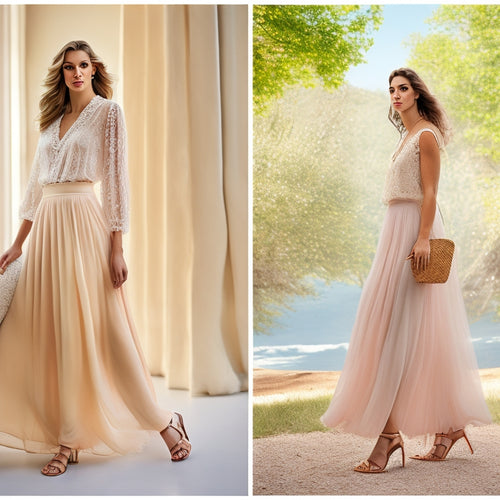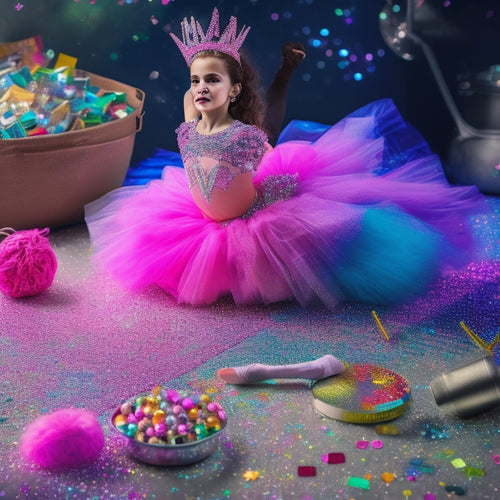
What Digital Marketing Strategies Work for Artists Online?
Share
You can establish a strong online presence as an artist by leveraging a combination of digital marketing strategies, including social media, content marketing, local SEO, and paid advertising, to showcase your work, connect with buyers, and build a loyal fan base that propels your career growth. By building a strong brand online, you'll increase your visibility, credibility, and ultimately, your sales. From showcasing your unique style on social media to creating valuable content that resonates with your audience, the right digital strategies can make all the difference. Now, discover how to tailor these strategies to your artistic vision and take your career to the next level.
Key Takeaways
• Establish a strong online presence by showcasing artwork and connecting with buyers through social media, websites, and online platforms.
• Leverage social media to build a loyal fan base, share artistic vision, and engage with fans and collectors through targeted content strategies.
• Utilize visual storytelling tools like interactive comics, virtual galleries, and stop-motion videos to convey artistic vision and showcase creative process.
• Implement content marketing strategies that provide valuable and relevant content, consistency, and personal branding to attract and retain a target audience.
• Optimize online presence with local SEO, paid advertising, and metrics tracking to maximize online visibility, engagement, and sales.
Building Online Presence Effectively
Establishing a strong online presence is essential for artists, as it allows them to showcase their work, connect with potential buyers, and ultimately, build a loyal fan base that drives their career forward. As an artist, you need to think of yourself as a brand, and your online presence is a representation of that brand.
This is where personal branding comes in – it's about creating a unique identity that sets you apart from others and showcases your artistic style. Your online reputation is also vital, as it can make or break your career. It's what people find when they search for you online, and it's what potential buyers, galleries, and collectors use to form an opinion about you.
Leveraging Social Media Platforms
As an artist, you're likely no stranger to social media, but are you leveraging these platforms to build your brand and showcase your artistic vision?
By using social media strategically, you can establish a strong online presence and connect with potential fans and collectors.
Now, let's explore how to harness the power of social media to build your artist brand and tell your unique visual story.
Building Artist Brand
You can leverage social media platforms to build your artist brand by showcasing your unique style, engaging with fans, and sharing behind-the-scenes content that humanizes your creative process. This helps to establish Artist Authenticity, which is essential in building a loyal fanbase. As you evolve as an artist, your brand evolves with you, and social media allows you to share this Brand Evolution with your audience.
Here are some ways to build your artist brand on social media:
| Platform | Content Strategy |
| Instagram | Share behind-the-scenes content, sneak peeks, and works-in-progress to humanize your creative process |
| Facebook | Share updates, promotions, and events to engage with fans and build a community |
| Twitter | Share bite-sized updates, quotes, and inspiration to build your personal brand |
| YouTube | Share video content, tutorials, and vlogs to showcase your expertise and creativity |
Visual Storytelling Tools
By harnessing the visual-centric nature of social media platforms, you can amplify your artist brand through strategic visual storytelling tools that help convey your artistic vision and captivate your audience.
To elevate your visual storytelling game, consider the following tools:
-
Interactive Comics: Share your artistic journey through interactive comics that bring your creative process to life. Platforms like Instagram and Facebook allow you to create engaging, step-by-step guides that showcase your artistic skills.
-
Virtual Galleries: Curate immersive online exhibitions that transport your audience into your artistic world. Virtual galleries can be shared on social media, giving your audience a 360-degree view of your artwork.
-
Stop-Motion Videos: Create mesmerizing stop-motion videos that showcase your artistic process, from sketch to finished piece. These bite-sized videos are perfect for Instagram and TikTok.
- Behind-the-Scenes Content: Give your audience a sneak peek into your creative process by sharing behind-the-scenes content, such as sketches, work-in-progress shots, and studio tours.
Content Marketing for Artists
What role does your online presence play in showcasing your artistic voice and style to potential fans and buyers, and how can you leverage content marketing to make a lasting impact?
As an artist, your online presence is essential in building your personal brand and establishing a connection with your audience. Content marketing is an effective way to showcase your creative freedom and artist voice, allowing you to share your unique perspective and style with the world.
By creating valuable and relevant content, you can attract and engage your target audience, driving profitable customer action. This can include blog posts, videos, social media content, and more. The key is to focus on providing value to your audience, rather than simply promoting your work. By doing so, you'll build trust and establish yourself as an authority in your niche.
Consistency is key in content marketing. Develop a content calendar to make sure you're regularly posting fresh content that resonates with your audience. This will help you build a loyal following and increase your online visibility. Remember, your content should be an extension of your artistic voice, showcasing your unique perspective and style.
Email Marketing Strategies Work
Building on your content marketing efforts, a targeted email marketing strategy can help you nurture leads and convert them into loyal fans and collectors. You can create personalized campaigns that speak directly to your audience, increasing engagement and driving sales.
Here are some strategies to get you started:
-
Abandoned Cart emails: Send reminders to customers who left items in their cart, enticing them to complete their purchase.
-
Creative Automation: Set up automated email sequences that trigger based on subscriber behavior, such as welcoming new subscribers or offering exclusive promotions.
-
Segmented Lists: Divide your email list into targeted groups based on interests, behaviors, or demographics, ensuring your message resonates with each group.
- Exclusive Offers: Share limited-time promotions, early access, or behind-the-scenes content to make your subscribers feel valued and appreciated.
Search Engine Optimization Tips
As an artist, you understand how important it's to get your work seen online. To increase your online visibility, you'll need to optimize your website and online presence for search engines.
Keyword Research Tools
You can supercharge your online presence by leveraging keyword research tools, which help you identify the most relevant and high-traffic keywords that resonate with your target audience. By using these tools, you can uncover hidden gems that your competitors may be overlooking, giving you a competitive edge in the online art market.
Here are some ways keyword research tools can benefit your online strategy:
-
Competitor analysis: Analyze your competitors' keywords to identify gaps in the market and opportunities to outrank them.
-
Long tail targeting: Identify niche keywords with lower competition and higher conversion rates.
-
Keyword clustering: Group related keywords to create targeted content and improve your website's structure.
- Keyword gap analysis: Identify keywords that your competitors are ranking for, but you're not, and optimize your content to fill those gaps.
Optimize Image File Names
When uploading your artwork online, it's easy to overlook the file names, but optimized image file names can greatly enhance your search engine rankings and drive more traffic to your website. You want to make it easy for search engines to understand what your image is about, so they can accurately index it and show it to people searching for similar content.
To optimize your image file names, you should include relevant keywords that describe your artwork. For example, if you're an artist who specializes in watercolor paintings of flowers, your file name might look like 'watercolor-flower-painting-blue-orchid.jpg'. This helps search engines understand the context and content of your image.
Don't forget to compress your images to reduce the file size, which will improve your website's loading speed. You can use tools like TinyPNG or ShortPixel to compress your images without sacrificing quality.
Local SEO for Artists
Targeting local art enthusiasts and potential buyers requires optimizing your online presence for local search engine results. This can be achieved by incorporating location-specific keywords and creating content that resonates with your local audience.
As an artist, you want to make sure that when people in your area search for art or art services, your name comes up. Here are some local SEO tips to get you started:
-
Claim and optimize your Google My Business listing: This will help you manage your online presence across Google and provide essential information to potential customers.
-
Get listed in local citations: Make sure your business is listed consistently across online directories and citations, such as Yelp, Bing Places, and other local listings.
-
Use location-specific keywords: Incorporate keywords related to your location into your website content, meta tags, and alt tags to attract local search traffic.
- Create locally-focused content: Develop content that speaks to your local audience, such as blog posts about local art events or exhibits.
Paid Advertising for Artists
By allocating a modest budget to paid advertising, artists can effectively amplify their online presence and reach a broader audience. With a well-planned ad budget, you can target specific demographics, interests, and behaviors to guarantee your message resonates with potential fans and buyers.
When it comes to targeting options, you have a range of choices. You can target by location, making sure your ads are seen by people in your local area or in specific cities where you're planning to exhibit or perform.
You can also target by interests, behaviors, or connections, allowing you to reach people who are already interested in art, music, or other creative pursuits. Additionally, you can target by lookalike audiences, which enables you to reach new people who resemble your existing fans or customers.
Measuring Online Success Metrics
How do you know if your digital marketing efforts are paying off and what metrics should you track to gauge your online success?
As an artist, it's important to measure the effectiveness of your online strategies to refine your approach and maximize your online presence.
To gauge your online success, track these essential metrics:
-
Website traffic: Monitor the number of visitors, page views, and bounce rates to understand your audience's behavior.
-
Conversion tracking: Set up conversion tracking to measure the number of sales, email sign-ups, or other desired actions on your website.
-
Social media engagement: Analyze engagement rates, such as likes, comments, and shares, to understand your social media presence.
- Return on Ad Spend (ROAS): Calculate the revenue generated by your paid advertising efforts to optimize your ad budget.
Frequently Asked Questions
Can I Use My Personal Social Media for My Art Business?
"Just like Superman has Clark Kent, you can separate your personal and artistic identities online, maintaining a professional boundary. Consider creating a dedicated art page, keeping your online identity intact, while you save your personal social media for, well, personal stuff."
How Do I Balance Creating Art and Marketing Online?
You balance creating art and marketing online by prioritizing time management, overcoming creative blocks with self-care, and staying true to your artistic identity, allowing your unique voice to shine through in both your art and online presence.
What if I'm Not Tech-Savvy, Can I Still Market Online?
Did you know 77% of online users consider online content more trustworthy than traditional media? You can still market online even if you're not tech-savvy; start with basic tutorials, online courses, and simple tools, and utilize beginner resources to get started.
How Often Should I Post New Artwork Online?
To maintain a strong online presence, you'll want to post new artwork regularly, ideally 3-5 times a week, using a content calendar to plan ahead, fostering audience engagement through visual storytelling and a consistent posting schedule.
Can I Sell My Art Directly From Social Media Platforms?
"Don't worry, you're not limited to just showcasing your art online - you can sell directly from social media platforms like Instagram Shops and Facebook Marketplace, leveraging your artistic branding, online exposure, and visual storytelling to drive sales through digital galleries."
Related Posts
-

3 Ways to Monetize Your Dance Expertise Online
You can harness your dance expertise into a lucrative online business by leveraging your skills in three key ways. Yo...
-

Elevate Your Style With These 3 Feminine Casual Wear Must-Haves
You're just a few stylish tweaks away from elevating your feminine casual wear from basic to breathtaking! Start by e...
-

Exclusive Crafting Files: Dance Mom Delight
Dance Mom Delight offers a wide collection of exclusive crafting files, providing users with a diverse range of digit...


